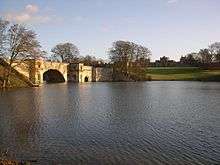Capability Brown
Lancelot Brown (born c. 1715–16, baptised 30 August 1716 – 6 February 1783),[1] more commonly known as Capability Brown, was an English landscape architect. He is remembered as "the last of the great English 18th-century artists to be accorded his due" and "England's greatest gardener".
Lancelot "Capability" Brown | |
|---|---|
_Brown_by_Nathaniel_Dance%2C_(later_Sir_Nathaniel_Dance-Holland%2C_Bt)_cropped.jpg) | |
| Born | Lancelot Brown Kirkharle, Northumberland, England |
| Baptised | 30 August 1716 |
| Died | 6 February 1783 (aged 67–68) London, England |
| Occupation | |
| Spouse(s) | Bridget Wayet ( m. 1744) |
| Children | 7 |
| Parent(s) |
|
He designed over 170 parks, many of which still endure. He was nicknamed "Capability" because he would tell his clients that their property had "capability" for improvement.[2] His influence was so great that the contributions to the English garden made by his predecessors Charles Bridgeman and William Kent are often overlooked; even Kent's champion Horace Walpole allowed that Kent "was succeeded by a very able master".[3]
Early life and Stowe
Lancelot Brown was born as a land agent's and chambermaid's fifth child in the village of Kirkharle, Northumberland, and educated at a school in Cambo until he was 16. Brown's father William Brown had been Sir William Loraine’s land agent and his mother Ursula (née Hall[4]) had been in service at Kirkharle Hall. His eldest brother John became the estate surveyor and later married Sir William's daughter. Elder brother George became a mason-architect.
After school Lancelot worked as the head gardener's apprentice at Sir William Loraine's kitchen garden at Kirkharle Hall till he was 23. In 1739 he journeyed south arriving at the port of Boston, Lincolnshire.[5] Then he moved further inland where his first landscape commission was for a new lake in the park at Kiddington Hall, Oxfordshire.[6] He moved to Wotton Underwood House, Buckinghamshire, seat of Sir Richard Grenville.[7]
In 1741,[8] Brown joined Lord Cobham's gardening staff as undergardener at Stowe, Buckinghamshire,[1] where he worked under William Kent, one of the founders of the new English style of landscape garden. At the age of 26 he was officially appointed as the Head Gardener in 1742, earning £25 (equivalent to £3,900 in 2019) a year and residing at the western Boycott Pavilion.
Brown was the head gardener at Stowe 1742-1750. He made the Grecian Valley at Stowe, which, despite its name, is an abstract composition of landform and woodland. Lord Cobham let Brown take freelance commission work from his aristocratic friends, thus making him well known as a landscape gardener. As a proponent of the new English style, Brown became immensely sought after by the landed families. By 1751, when Brown was beginning to be widely known, Horace Walpole wrote somewhat slightingly of Brown's work at Warwick Castle:
- The castle is enchanting; the view pleased me more than I can express, the River Avon tumbles down a cascade at the foot of it. It is well laid out by one Brown who has set up on a few ideas of Kent and Mr. Southcote.
By the 1760s, he was earning on average £6,000 (equivalent to £826,000 in 2019) a year, usually £500 (equivalent to £68,800 in 2019) for one commission. As an accomplished rider he was able to work fast, taking only an hour or so on horseback to survey an estate and rough out an entire design. In 1764, Brown was appointed King George III's Master Gardener at Hampton Court Palace, succeeding John Greening and residing at the Wilderness House.[7] In 1767 he bought an estate for himself at Fenstanton in Huntingdonshire from the Earl of Northampton and was appointed High Sheriff of Cambridgeshire and Huntingdonshire for 1770, although his son Lance carried out most of the duties.[9]
Landscape gardens
It is estimated that Brown was responsible for over 170 gardens surrounding the finest country houses and estates in Britain. His work still endures at Belvoir Castle, Croome Court (where he also designed the house), Blenheim Palace, Warwick Castle, Harewood House, Highclere Castle, Appuldurcombe House, Milton Abbey (and nearby Milton Abbas village), and in traces at Kew Gardens and many other locations.[10]
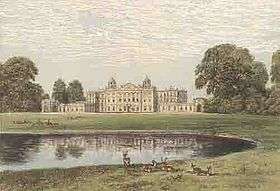
His style of smooth undulating grass, which would run straight to the house, clumps, belts and scattering of trees and his serpentine lakes formed by invisibly damming small rivers, were a new style within the English landscape, a "gardenless" form of landscape gardening, which swept away almost all the remnants of previous formally patterned styles.
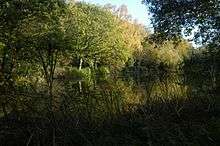
His landscapes were at the forefront of fashion. They were fundamentally different from what they replaced, the well-known formal gardens of England which were criticised by Alexander Pope and others from the 1710s. Starting in 1719, William Kent replaced these with more naturalistic compositions, which reached their greatest refinement in Brown's landscapes.
At Hampton Court, Brown encountered Hannah More in 1782 and she described his "grammatical" manner in her literary terms: "'Now there' said he, pointing his finger, 'I make a comma, and there' pointing to another spot, 'where a more decided turn is proper, I make a colon; at another part, where an interruption is desirable to break the view, a parenthesis; now a full stop, and then I begin another subject'".[11] Brown's patrons saw the idealised landscapes he was creating for them in terms of the Italian landscape painters they admired and collected, as Kenneth Woodbridge first observed in the landscape at Stourhead, a "Brownian" landscape (with an un-Brownian circuit walk) in which Brown himself was not involved.
Criticism
Perhaps Brown's sternest critic was his contemporary Uvedale Price, who likened Brown's clumps of trees to "so many puddings turned out of one common mould."[12] Russell Page, who began his career in the Brownian landscape of Longleat but whose own designs have formal structure, accused Brown of "encouraging his wealthy clients to tear out their splendid formal gardens and replace them with his facile compositions of grass, tree clumps and rather shapeless pools and lakes."[13]
Richard Owen Cambridge, the English poet and satirical author, declared that he hoped to die before Brown so that he could "see heaven before it was 'improved'." This was a typical statement reflecting the controversy about Brown's work, which has continued over the last 200 years. By contrast, a recent historian and author, Richard Bisgrove, described Brown's process as perfecting nature by "judicious manipulation of its components, adding a tree here or a concealed head of water there. His art attended to the formal potential of ground, water, trees and so gave to English landscape its ideal forms. The difficulty was that less capable imitators and less sophisticated spectators did not see nature perfected... they saw simply what they took to be nature."
This deftness of touch was recognised in his own day; one anonymous obituary writer opined: "Such, however, was the effect of his genius that when he was the happiest man, he will be least remembered; so closely did he copy nature that his works will be mistaken." In 1772, Sir William Chambers (though he did not mention Brown by name) complained that the "new manner" of gardens "differ very little from common fields, so closely is vulgar nature copied in most of them."[14]
Architecture
Capability Brown produced more than 100 architectural drawings,[15] and his work in the field of architecture was a natural outgrowth of his unified picture of the English country house in its setting:
"In Brown's hands the house, which before had dominated the estate, became an integral part of a carefully composed landscape intended to be seen through the eye of a painter, and its design could not be divorced from that of the garden"[6]
Humphry Repton observed that Brown "fancied himself an architect",[16] but Brown's work as an architect is overshadowed by his great reputation as a designer of landscapes. Repton was bound to add: "he was inferior to none in what related to the comfort, convenience, taste and propriety of design, in the several mansions and other buildings which he planned". Brown's first country house project was the remodelling of Croome Court, Worcestershire, (1751–52) for the 6th Earl of Coventry, in which instance he was likely following sketches by the gentleman amateur Sanderson Miller.[6]
Fisherwick, Staffordshire, Redgrave Hall, Suffolk, and Claremont, Surrey, were classical, while at Corsham his outbuildings are in a Gothic vein, including the bathhouse. Gothick stable blocks and decorative outbuildings, arches and garden features constituted many of his designs. From 1771 he was assisted in the technical aspects by the master builder Henry Holland, and by Henry's son Henry Holland the architect, whose initial career Brown supported; the younger Holland was increasingly Brown's full collaborator and became Brown's son-in-law in 1773.
Subsequent reputation
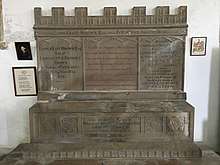
Brown's reputation declined rapidly after his death, because the English Landscape style did not convey the dramatic conflict and awesome power of wild nature. A reaction against the harmony and calmness of Brown's landscapes was inevitable; the landscapes lacked the sublime thrill which members of the Romantic generation (such as Richard Payne Knight and Uvedale Price) looked for in their ideal landscape, where the painterly inspiration would come from Salvator Rosa rather than Claude Lorrain.
During the 19th century he was widely criticised,[17] but during the twentieth century his reputation rose again. Tom Turner has suggested that the latter resulted from a favourable account of his talent in Marie-Luise Gothein's History of Garden Art which predated Christopher Hussey's positive account of Brown in The Picturesque (1927). Dorothy Stroud wrote the first full monograph on Capability Brown, fleshing out the generic attributions with documentation from country house estate offices.
Later landscape architects like William Gilpin would opine that Brown's 'natural curves' were as artificial as the straight lines that were common in French gardens.[18] Brown's portrait by Nathaniel Dance, c. 1773, is conserved in the National Portrait Gallery, London. His work has often been favourably compared and contrasted ("the antithesis") to the œuvre of André Le Nôtre, the French jardin à la française landscape architect.[1][19] He became both "rich and honoured and had 'improved' a greater acreage of ground than any landscape architect" who preceded him.[1][18]
A festival to celebrate the tercentenary of Brown's birth was held in 2016. The Capability Brown Festival 2016[20] published a large amount of new research on Brown's work[21] and held over 500 events across Britain as part of the celebrations.[22] Royal Mail issued a series of Landscape Stamps[23] in his honour in August 2016.
The Gardens Trust with support from Historic England, published Vulnerability Brown: Capability Brown landscapes at risk[24] in October 2017 to review the issues facing the survival of these landscapes as well as suggested solutions.
A commemorative fountain in Westminster Abbey’s cloister garth was dedicated for Lancelot ‘Capability’ Brown after Evensong on Tuesday 29 May 2018 by the Dean of Westminster, the Very Reverend Dr John Hall. The fountain sits over an old monastic well in the garth. It was designed by Ptolemy Dean, the Abbey's Surveyor of the Fabric, and was developed with the assistance of gardener Alan Titchmarsh. The fountain was made in lead by sculptor Brian Turner.[25]
Personal life
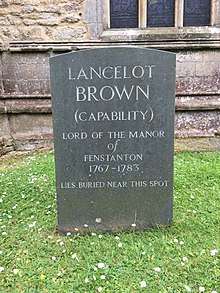
On 22 November 1744 he married in Stowe parish church, Bridget Wayet (affectionately called Biddy) from Boston, Lincolnshire.[26] Her father was an alderman and landowner while her family had surveyors and engineers among its members. They had seven children: Bridget in 1746, Lancelot (known as Lance), William (who died young), John in 1751, a son in 1754 who died shortly afterwards, Anne who was born and died in 1756, Margaret (known as Peggy) in 1758 and Thomas in 1761.[27]
In 1768 he purchased the manor of Fenstanton in Huntingdonshire in East Anglia for £13,000 from Lord Northampton. This came with two manor houses, two villages and 2,668 acres of land.[28] The property stayed in the family until it was sold in lots in 1870s and 1880s. Ownership of the property allowed him to stand for and serve as High Sheriff of Huntingdonshire from 1770 to 1771.[29] He continued to work and travel until his sudden collapse and death on 6 February 1783, on the doorstep of his daughter Bridget Holland's house, at 6 Hertford Street, London while returning after a night out at Lord Coventry's.[30]
Horace Walpole wrote to Lady Ossory: "Your dryads must go into black gloves, Madam, their father-in-law, Lady Nature’s second husband, is dead!".[31] Brown was buried in the churchyard of St. Peter and St. Paul, the parish church of Brown's small estate at Fenstanton Manor.[32] He left an estate of approximately £40,000, which included property in Cambridgeshire, Huntingdonshire and Lincolnshire.[33] His eldest daughter Bridget married the architect Henry Holland. Brown sent two of his sons to Eton. One of them, Lancelot Brown the younger, became the MP for Huntingdon. His son John joined the Royal Navy and rose to become an admiral.
Gardens and parks
Many of Capability Brown's parks and gardens may still be visited today. A partial list of the landscapes he designed or worked on includes:
- Adderbury House, Oxfordshire (designs not thought to be implemented)[34]
- Addington Place, Croydon
- Alnwick Castle, Northumberland
- Althorp, Northamptonshire
- Ampthill Park, Ampthill, Bedfordshire
- Ancaster House, Richmond, Surrey
- Appuldurcombe House, Isle of Wight
- Ashburnham Place, East Sussex
- Ashridge House, Hertfordshire
- Aske Hall, North Yorkshire
- Astrop Park, Northamptonshire
- Audley End, Essex
- Aynhoe Park, Northamptonshire
- The Backs, Cambridge
- Badminton House, Gloucestershire
- Ballyfin House, Ireland
- Basildon Park, Berkshire
- Battle Abbey, East Sussex
- Beaudesert, Staffordshire
- Beechwood, Bedfordshire
- Belhus, Essex
- Belvoir Castle, Leicestershire
- Benham, Berkshire
- Benwell Tower, near Newcastle upon Tyne
- Berrington Hall, Herefordshire
- Blenheim Palace, Oxfordshire
- Boarstall, Buckinghamshire (unknown if work carried out)[35]
- Bowood House, Wiltshire
- Branches Park, Cowlinge, Suffolk
- Brentford, Ealing
- Brightling Park, Sussex
- Broadlands, Hampshire
- Brocklesby Park, Lincolnshire
- Burghley House, Lincolnshire
- Burton Constable Hall, East Riding of Yorkshire
- Burton Park, Sussex
- Burton Pynsent, Somerset
- Byram, West Yorkshire
- Cadland, Hampshire
- Capheaton Hall, Northumberland
- Cardiff Castle, Cardiff
- Castle Ashby House, Northamptonshire[36]
- Caversham, Berkshire
- Chalfont House, Buckinghamshire
- Charlecote, Warwickshire
- Charlton, Wiltshire
- Chatsworth, Derbyshire
- Chilham Castle, Kent
- Chillington Hall, West Midlands
- Church Stretton Old Rectory, Shropshire
- Clandon Park, Surrey
- Claremont, Surrey
- Clumber Park, Nottinghamshire
- Compton Verney, Warwickshire
- Coombe Abbey, Coventry
- Corsham Court, Wiltshire
- Croome Park, Worcestershire
- Dodington Park, Gloucestershire
- Danson Park, Bexley Borough of London
- Darley Abbey Park, Derby
- Euston Hall, Suffolk
- Farnborough Hall, Warwickshire
- Fawley Court, Oxfordshire
- Gatton Park, Surrey
- Grimsthorpe Castle, Lincolnshire
- Hampton Court Palace, Surrey[7]
- Harewood House, Leeds
- Heveningham Hall, Suffolk
- Highclere Castle, Hampshire
- Highcliffe Castle, Dorset
- Himley Hall, Staffordshire
- Holkham Hall, Norfolk
- Holland Park, London
- The Hoo, Hertfordshire
- Hornby Castle, North Yorkshire
- Howsham, near York
- Ickworth, Suffolk
- Ingestre, Staffordshire
- Ingress Abbey, Kent
- Kelston, Somerset
- Kew Gardens, South West London[10]
- Kiddington Hall, Oxfordshire
- Kimberley, Norfolk
- Kimbolton Castle, Cambridgeshire
- King's Weston House, Bristol
- Kirkharle, Northumberland
- Kirtlington, Oxfordshire
- Knowsley, near Liverpool
- Kyre Park, Herefordshire
- Lacock Abbey, Wiltshire
- Laleham Abbey, Surrey
- Langley, Berkshire
- Langley Park, Norfolk
- Latimer, Buckinghamshire
- Leeds Abbey, Kent
- Littlegrove, Barnet, London
- Lleweni Hall, Clwyd
- Longford Castle, Wiltshire
- Longleat, Wiltshire
- Lowther, Cumbria
- Luton Hoo, Bedfordshire
- Madingley Hall, Cambridgeshire
- Maiden Earley, Berkshire
- Mamhead House, Devon
- Melton Constable Hall, Norfolk
- Milton Abbey, Dorset
- Moccas Court, Herefordshire
- Moor Park, Rickmansworth, Hertfordshire
- Mount Clare, Roehampton, South West London
- Navestock, Essex
- Newnham Paddox, Warwickshire
- Newton Park, Newton St Loe, Somerset
- New Wardour Castle, Wiltshire
- North Cray Place, near Sidcup, Bexley, London
- North Stoneham Park, Eastleigh, Hampshire
- Nuneham Courtenay, Oxfordshire
- Oakley, Shropshire
- Packington Park, Warwickshire
- Paddenswick Manor, West London
- Patshull Hall, Staffordshire
- Paultons Park, Hampshire
- Peper Harow, Surrey
- Peterborough House, Hammersmith, London
- Petworth House, West Sussex
- Pishiobury, Hertfordshire
- Porter's Park, Hertfordshire
- Prior Park, Somerset
- Ragley Hall, Warwickshire
- Redgrave Park, Suffolk
- Roche Abbey, South Yorkshire
- Sandleford, Berkshire
- Savernake Forest, Wiltshire
- Schloss Richmond (Richmond Palace) in Braunschweig, Germany
- Scampston Hall, North Yorkshire
- Sheffield Park Garden, Sussex
- Sherborne Castle, Dorset
- Sledmere House, East Riding of Yorkshire
- Southill Park, Bedfordshire
- South Stoneham House, Southampton, Hampshire
- Stoke Park, Buckinghamshire
- Stowe Landscape Garden
- Syon House, West London
- Temple Newsam, Leeds
- Thorndon Hall, Essex
- Trentham Gardens, Staffordshire
- Ugbrooke Park, Devon
- Wallington, Northumberland[37]
- Warwick Castle, Warwick
- Wentworth Castle, South Yorkshire
- West Hill, Putney, South London
- Weston Park, Staffordshire
- Whitehall, London
- Whitley Beaumont, West Yorkshire
- Widdicombe Park, near Slapton, Devon
- Wimbledon House, South West London
- Wimbledon Park, South West London
- Wimpole Hall, Cambridgeshire
- Woburn Abbey, Bedfordshire
- Wolterton Hall, Norfolk
- Woodchester, Gloucestershire
- Woodside, Berkshire
- Wootton Place Rectory, Oxfordshire
- Wotton, Buckinghamshire
- Wrest Park, Bedfordshire
- Wrotham Park, Hertfordshire
- Wycombe Abbey, Buckinghamshire
- Wynnstay, Clwyd, Wales
- Youngsbury, Hertfordshire
More than 30 of the gardens are open to the public.[38]
See also
Notes
- "Lancelot Brown". Encyclopædia Britannica, Encyclopædia Britannica Online. Encyclopædia Britannica Inc. 2007. Retrieved 12 March 2012.
- McKenna, Steve (17 April 2016). "Highclere Castle: The real-life Downton Abbey". The Sydney Morning Herald. Retrieved 18 April 2016.
- Walpole, Horace (1905) [1780]. On Modern Gardening. Canton, Pa.: Kirgate Press. p. 87. at Internet Archive
- "About Capability Brown | Capability Brown". www.capabilitybrown.org. Archived from the original on 15 February 2018. Retrieved 7 June 2018.
- Brown 2011
- Colvin 1995.
- Lancelot 'Capability' Brown Date: 1716 – 1783 Landscape Gardener, The Twickenham Museum, archived from the original on 14 February 2012, retrieved 14 March 2012
- Hinde, Thomas (1986), Capability Brown: the Story of a Master Gardener, London: Hutchinson, p. 19, ISBN 0-09-163740-6
- "HOW THE MANOR OF FENSTANTON WAS EXCHANGED FOR TASTE" (PDF). Cambridgeshire Gardens Trust. Archived from the original (PDF) on 28 March 2016. Retrieved 18 March 2016.
- "Lancelot 'Capability' Brown (1716–1783)". Kew History & Heritage. Kew Gardens. Archived from the original on 8 October 2012. Retrieved 16 March 2012.
- Quoted in Peter Willis, "Capability Brown in Northumberland" Garden History 9.2 (Autumn, 1981, pp. 157–183) p. 158.
- Uvedale Price. An Essay on the Picturesque. J. Robson, London, 1796. Page 268. (In the 1794 edition this is on page 191.)
- Page, Russell (3 May 1994) [1962]. Education of a Gardener (Paperback). The Harvill Press. p. 384. ISBN 0-00-271374-8. ISBN 978-0-00-271374-0
- Chambers, William (1772). A Dissertation on Oriental Gardening. W. Griffin. p. v.
- Rutherford, Sarah; Evans, Ceryl (2019). "Capability Brown's Drawings: A Reference Catalogue of Drawings by Brown or his Office (c.1740s–83) Including Architectural Drawings and Landscape Scenes". Historic England. Retrieved 30 August 2019.
- Repton, Humphry (1752–1818); Repton, John Adey (1775–1860) (1803). Observations on the Theory and Practice of Landscape Gardening. London: T. Bensley. at Internet Archive.
- "Sir Uvedale Price, 1st Baronet". Encyclopædia Britannica. Encyclopædia Britannica Online. 2012. Retrieved 12 March 2012.
- Clifford, Derek Plint (2012). "Garden and landscape design". Encyclopædia Britannica, Encyclopædia Britannica Online. Encyclopædia Britannica Inc. Retrieved 14 March 2012.
- "André Le Nôtre". Encyclopædia Britannica. Encyclopædia Britannica Inc. 12 March 2012. Retrieved 12 March 2012.
- "Home page | Capability Brown". www.capabilitybrown.org. Retrieved 7 June 2018.
- "INTERACTIVE MAP | Capability Brown". www.capabilitybrown.org. Archived from the original on 8 April 2019. Retrieved 7 June 2018.
- "Executive Summary of Evaluation Report on the Capability Brown Festival 2016" (PDF).
- "Royal Mail Marks 300th Anniversary of Capability Brown's Birth - News | Capability Brown". www.capabilitybrown.org. Archived from the original on 8 April 2019. Retrieved 7 June 2018.
- "Vulnerability Brown" (PDF).
- "'Capability' Brown fountain dedicated". Westminster Abbey. Retrieved 7 June 2018.
- Rutherford. Page 32.
- Rutherford. Pages 33, 35, 36.
- Rutherford. Page 42.
- "A Capable Sheriff". Capability Brown Festival. 2016. Archived from the original on 8 April 2019. Retrieved 12 August 2018.
- Rutherford. Page 43.
- Walpole, Horace (1861). "The Letters of Horace Walpole: Earl of Orford". Bohn's English Gentleman's Library. Covent Garden; London: Bradbury and Evans; Henry G. Bohn. 8: 331. Retrieved 13 March 2012.
- I Never Knew That About England's Country Churches
- Rutherford. Page 44.
- "Adderbury Conservation Area Appraisal" (PDF). Cherwell District Council. September 1997. Archived from the original (PDF) on 10 May 2017. Retrieved 13 March 2012.
- Boarstall people
- Turner, Roger (1999). Capability Brown and the Eighteenth Century English Landscape (2nd ed.). Chichester: Phillimore. pp. 112–114.
- Pevsner, N., et al. 1992, The Buildings of England: Northumberland
- Ross, David. "Capability Brown biography". Britain Express. Retrieved 14 March 2012.
References
- Brown, Jane (2011), The Omnipotent Magician: Lancelot "Capability" Brown, 1716–1783, London: Chatto & Windus, ISBN 0-7011-8212-1 ISBN 978-0-7011-8212-0.
- Colvin, Howard (1995) [1954], A Biographical Dictionary of British Architects 1600–1840 (3rd ed.), New Haven: Yale University Press, p. 1264, ISBN 978-0-300-06091-1
- Colvin, Howard (2008) [1954], A Biographical Dictionary of British Architects, 1600–1840 (4th ed.), New Haven: Yale University Press, ISBN 978-0-300-12508-5
- Hinde, Thomas (1987), Capability Brown: The Story of a Master Gardener, New York: W. W. Norton, ISBN 0-393-02421-0 ISBN 0-09-163740-6.
- Stroud, Dorothy (1975) [1950], Capability Brown (2nd revised ed.), London: Faber and Faber, ISBN 0-571-10267-0 ISBN 0-571-13405-X.
- Rutherford, Sarah (2016). Capability Brown and His Landscape Gardens (Hardback). London: National Trust Books. ISBN 978-1-909-88154-9.
- Turner, Roger (1985), Capability Brown and the Eighteenth Century English Landscape, New York: Rizzoli, ISBN 0-8478-0643-X 2nd edition, Phillimore, Chichester (1999) ISBN 0-297-78734-9, ISBN 1-86077-114-9.
Further reading
- Amherst, Alicia (2006) [1910], A History of Gardening in England (3rd ed.), Whitefish, Montana: Kessinger Publishing
- Blomfield, Sir F. Reginald; Thomas, Inigo, Illustrator (1972) [1901], The Formal Garden in England, 3rd ed., New York: Macmillan and Co
- Clifford, Derek (1967), A History of Garden Design (2nd ed.), New York: Praeger
- Gothein, Marie-Luise Schröeter (1863–1931); Wright, Walter P. (1864–1940); Archer-Hind, Laura; Alden Hopkins Collection (1928) [1910], History of Garden Art, 2, London & Toronto, New York: J. M. Dent; 1928 Dutton, p. 945, ISBN 978-3-424-00935-4 Publisher: Hacker Art Books; Facsimile edition (June 1972) ISBN 0-87817-008-1; ISBN 978-0-87817-008-1.
- Gothein, Marie. Geschichte der Gartenkunst. München: Diederichs, 1988 ISBN 978-3-424-00935-4.
- Hadfield, Miles (1960), Gardening in Britain, Newton, Mass: C. T. Branford
- Heath, Gerald; White, Kathy, Editor; Heath, Joan. Editor (2000), Hampton Court: The Story of a Village (Print), Middlesex, England: The Hampton Court Association, ISBN 0-9538700-0-6
- Hussey, Christopher (1967), English Gardens and Landscapes, 1700–1750, Country Life
- Hyams, Edward S.; Smith, Edwin, photos (1964), The English Garden, New York: H.N. Abrams
- Thurley, Simon (2003), Hampton Court, A Social and Architectural History (print), New Haven: Yale University Press Published for the Paul Mellon Centre for Studies in British Art, ISBN 0300102232 ISBN 978-0300102239
External links
![]()
- "Lancelot Brown". Encyclopædia Britannica, Encyclopædia Britannica Online. Encyclopædia Britannica Inc. 2007. Retrieved 12 March 2012.
- "Capability Brown — 300 years". capabilitybrown.org.uk. Retrieved 27 November 2014.
- Britten, Nick (19 February 2009). "Capability Brown's first garden plan to be brought to life after 250 years". The Daily Telegraph. Retrieved 13 March 2012.
- "Archival material relating to Capability Brown". UK National Archives.

- Portraits of Capability Brown at the National Portrait Gallery, London

- FT review of Compton Verney 2011 exhibition
- Capability Brown's unfinished garden
- Google. "Capability Brown Statue by Laury Dizengremel, 2017" (Map). Google Maps. Google.
